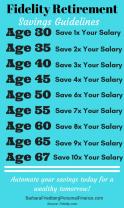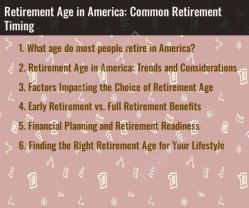How to retire, step by step?
Navigating retirement involves careful planning and considerations. Here's a step-by-step guide to help you prepare for retirement:
Step 1: Determine Retirement Goals
- Set Goals: Define what you want your retirement to look like. Consider lifestyle, travel, hobbies, and any other aspirations.
Step 2: Assess Financial Readiness
- Financial Assessment: Evaluate your current financial situation, including savings, investments, pensions, and debts.
- Calculate Retirement Needs: Estimate your retirement expenses and income. Consider healthcare costs, living expenses, and leisure activities.
Step 3: Develop a Retirement Plan
- Create a Budget: Develop a detailed budget outlining your anticipated expenses in retirement.
- Explore Retirement Accounts: Maximize contributions to retirement accounts like 401(k)s, IRAs, or other pension plans.
- Consider Long-Term Care: Investigate long-term care insurance or other strategies to cover potential healthcare expenses.
- Explore Income Streams: Investigate additional income sources like part-time work, rental properties, or passive income streams.
Step 4: Optimize Investments
- Adjust Investment Strategy: Shift your investment portfolio to a more conservative mix as retirement approaches. Seek professional advice if needed.
- Diversify Portfolio: Diversify investments to balance risk and potential returns.
Step 5: Social Security and Medicare
- Understand Social Security: Learn about Social Security benefits and determine the optimal time to start claiming them.
- Plan for Medicare: Familiarize yourself with Medicare options and enrollment deadlines.
Step 6: Legal and Estate Planning
- Create a Will: Draft or update a will, and consider establishing trusts or powers of attorney.
- Review Beneficiaries: Ensure your retirement accounts and insurance policies have up-to-date beneficiary designations.
Step 7: Transitioning to Retirement
- Test Retirement Budget: Try living on your retirement budget before retiring to ensure it's feasible.
- Decide Retirement Date: Set a retirement date based on financial readiness and personal preferences.
- Explore Post-Retirement Activities: Plan how you'll spend your time in retirement and consider volunteering, travel, or pursuing hobbies.
Step 8: Implementing the Plan
- Execute the Plan: Start transitioning assets, adjusting investment portfolios, and finalizing legal documents as needed.
- Stay Flexible: Regularly review and adjust your retirement plan as circumstances change.
Step 9: Enjoy Retirement
- Embrace Retirement: Relax and enjoy the fruits of your labor. Stay active, socially engaged, and pursue activities that bring fulfillment.
Remember, seeking advice from financial planners, retirement specialists, and legal professionals can provide invaluable guidance tailored to your specific situation and goals. Adjust your plan as needed and stay adaptable throughout your retirement journey.
Sequential Actions for Retirement Preparation:
1. Early Stages (20s and 30s):
- Understand Social Security: Learn about your potential Social Security benefits and how you can maximize them.
- Assess Current Financial Health: Calculate your net worth and track your income and expenses.
- Set Retirement Goals: Define your desired lifestyle in retirement and estimate your needed income.
- Begin Saving: Start saving early and consistently, even if it's a small amount.
- Explore Retirement Accounts: Choose appropriate retirement accounts like 401(k) or IRAs and contribute regularly.
- Reduce Debt: Prioritize paying off high-interest debt to improve cash flow.
2. Mid-Career (40s and 50s):
- Increase Savings Rate: Gradually increase your retirement savings percentage to reach your goals.
- Re-Evaluate Retirement Plan: Adjust your plan based on life changes and updated income projections.
- Diversify Investments: Invest in a mix of asset classes for long-term growth and risk management.
- Maximize Employer Benefits: Contribute to employer-sponsored retirement plans and take advantage of any matching contributions.
- Seek Professional Advice: Consider consulting a financial advisor for personalized guidance.
3. Pre-Retirement (50s and 60s):
- Estimate Retirement Expenses: Refine your retirement budget considering healthcare costs and potential inflation.
- Review Investment Portfolio: Rebalance your portfolio to ensure it aligns with your shorter time horizon.
- Plan for Healthcare: Research Medicare options and consider long-term care insurance.
- Downsize Expenses: Reduce unnecessary expenses and explore debt payoff strategies.
- Finalize Retirement Date: Determine your ideal retirement date and discuss it with your employer.
4. Retirement:
- Start Receiving Retirement Income: Access your retirement savings and Social Security benefits.
- Manage Your Budget: Monitor your spending and adjust as needed to maintain your desired lifestyle.
- Stay Active: Engage in activities you enjoy to maintain physical and mental well-being.
- Continue Learning: Pursue new interests and explore your passions to stay engaged in life.
Comprehensive Steps for a Well-Planned Retirement Transition:
1. Financial Planning:
- Calculate your retirement needs: Estimate your expenses and income sources in retirement.
- Create a retirement budget: Track and manage your spending to ensure it aligns with your budget.
- Develop an investment strategy: Invest in a diversified portfolio to achieve your retirement goals.
- Pay off debt: Focus on eliminating high-interest debt before retirement.
- Review your insurance coverage: Ensure adequate health and long-term care insurance.
2. Lifestyle Planning:
- Define your ideal retirement lifestyle: Consider where you want to live, activities you want to pursue, and how you will spend your time.
- Downsize your living space: Consider downsizing your home to reduce expenses and maintenance.
- Develop hobbies and interests: Explore new activities and passions to stay engaged and fulfilled.
- Build strong social connections: Maintain relationships with family and friends and explore new social circles.
3. Healthcare Planning:
- Understand your Medicare options: Learn about enrollment periods, coverage options, and supplement plans.
- Plan for long-term care needs: Explore long-term care insurance or other care options.
- Maintain a healthy lifestyle: Eat healthy, exercise regularly, and manage chronic conditions.
- Prepare legal documents: Create a will, power of attorney, and healthcare directives.
4. Estate Planning:
- Create a will: Divide your assets according to your wishes.
- Designate beneficiaries: Assign beneficiaries for your retirement accounts and life insurance policies.
- Plan for long-term care expenses: Determine how to cover potential long-term care costs.
- Review your financial documents regularly: Update your plans as needed to reflect changing circumstances.
By taking these sequential actions and comprehensive steps, individuals can prepare for a smooth and well-planned transition into retirement. Remember, the earlier you start planning, the better prepared you will be for a secure and fulfilling retirement.











